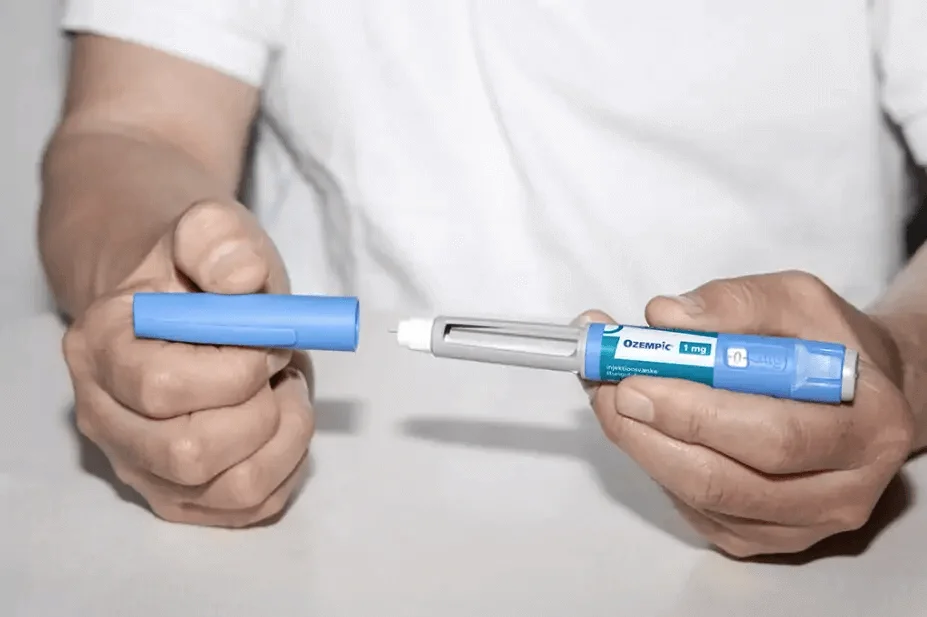Key Takeaways
-
Know how GLP-1 drugs work to reduce hunger, slow stomach emptying, and improve blood sugar to strategize lifestyle changes that complement lasting results.
-
Anticipate biologic rebound after stopping medication and plan ahead by ramping up activity, monitoring intake, and weighing and measuring yourself to detect regain early.
-
Reorient nutrition to protein- and fiber-heavy, low-glycemic foods and schedule meals with your goal to stay satiated, with stable blood sugar without the help of drugs.
-
Focus on strength training and frequent movement to retain muscle, boost metabolism, and account for energy requirements in maintenance mode.
-
Use non-scale metrics and health markers like waist circumference, body composition, blood sugar, and energy levels to measure progress and guide adjustments.
-
Collaborate with experts such as an obesity specialist or registered dietitian for individualized plans, check-ins, and assistance navigating off-medication transitions.
How to maintain results after weight loss drugs is a strategic regimen of lifestyle choices that stabilize weight post-medication. It addresses diet, exercise, sleep, and regular visits to retain gains.
Healthy eating habits and consistent moderate activity reduce the risk of regaining weight. Tracking this with some simple measures and working with your clinician helps you adjust your care over time.
The heart of the book provides habits, example plans, and follow-up advice.
Understanding GLP-1s
GLP-1 receptor agonists are drugs that mimic a natural gut hormone, glucagon-like peptide-1, to reduce appetite and alter how your body processes food. They work on several fronts: they tell the brain to feel full sooner, they slow how fast the stomach empties, and they boost insulin release when glucose is high. Those joint effects account for why so many people experience significant weight loss.
Studies show around 18.3% body weight lost at 12 months and mean losses as high as 25.5% at 18 months for specific responders.
Brain Signals
GLP-1s influence brain mechanisms regulating hunger and food reward. They suppress activity in areas associated with craving and boost signals that indicate ‘stop eating,’ which decreases craving for calorie-rich, sugary foods. There is an effect on hypothalamic leptin sensitivity: GLP-1 therapy can restore some leptin response, helping the brain reset a lower body-weight set point.
Neurotransmitter changes soon follow, with shifts in dopamine and serotonin signaling that minimize compulsive eating and assist with portion control. Eventually, these neural shifts can help sustain maintenance after medication ceases, though continued follow-up and behavioral effort are required to keep changes long-lasting.
Stomach Pacing
GLP-1 receptor agonists slow gastric emptying, so food remains in the stomach longer and satiety persists post meals. That delay reduces calorie intake naturally because individuals feel satiated by smaller quantities. To extract maximum benefit from decelerated stomach pacing, consume well-rounded meals with protein, fiber, and healthy fats.
These help extend satiety and blunt hunger in between meals. Track meal timing and listen to actual satiety signals instead of clock hunger. Logging when you’re full and for how long can help direct portion sizes and avoid creeping calorie intake once medication is tapered.
Blood Sugar
GLP-1 drugs increase insulin secretion in response to food and enhance insulin sensitivity, which smooths blood sugar spikes and reduces diabetes risk. Stable blood glucose helps steady energy and curb carb cravings that fuel overeating. Frequent checks are necessary during weight maintenance to identify spikes or troughs, particularly when modifying diet or discontinuing medication.
Favor low-glycemic staples like whole grains, legumes, and vegetables to keep glucose steady. Consider adjuncts like metformin, which can enhance insulin resistance and increase endogenous GLP-1 secretion; it is typically part of a longer strategy.
Regular follow-up matters. Average care includes about 4.1 provider visits in the first year, yet adherence drops and only 4.7% follow up at 24 months, so set a plan for ongoing check-ins and 60 minutes of daily activity plus 2 to 3 weekly resistance sessions to preserve gains.
The Biological Rebound
Stopping weight loss drugs often triggers a biological rebound: hormonal and metabolic shifts push the body back toward its prior weight. Weight can continue to decline up to four weeks after cessation of medication and then begins to increase again by eight weeks, with numerous studies demonstrating significant rebound weight within six months.
After discontinuation of semaglutide plus a structured lifestyle program, they regained about two-thirds of the lost weight over a one-year off-treatment period. Rebound can be swift and significant. Some studies see evidence of improvements as early as eight weeks, and in long-term follow-up, patients gained back over 5% of lost weight 15 years after reaching their lowest weight.
Cardiometabolic benefits observed on GLP-1 treatment usually shift back toward baseline once the medication ceases. These rhythms imply active planning is necessary to maintain results.
Appetite’s Return
Appetite suppression from GLP‑1 drugs wanes, hunger frequently returns with an enhanced vigor. Anticipate more frequent eating cues and more acute cravings for calorie‑dense foods.
Watch for early signs, wanting larger portions, snacking more often, or thinking about food constantly. Apply mindful eating to tame this surge. Eat slower, pay attention to satiety signals, and don’t eat on the run.
About the biological rebound, establish consistent meal times, strive for balanced plates with protein, fiber, and healthy fats, and strategically schedule snacks to prevent spur of the moment decisions. Examples include 120 to 150 grams of lean protein at lunch, a 30-gram high-fiber snack midafternoon, and a 400 to 600-gram mix of vegetables across the day.
If hunger spikes, adapt fast. Trade refined carbs for whole grains, up your protein at the subsequent meal, and leverage low-calorie volume foods such as broth-based soups or salads to dampen appetite. Monitoring consumption for a couple of weeks can reveal trends, and it can steer minor, initial modifications before mass moves.
Metabolic Shift
Metabolic rate tends to decrease after discontinuing GLP‑1, such that the body expends fewer kilojoules in resting and active states. This reduced energy use makes it easier to gain weight unless intake or activity is adjusted.
Build and maintain muscle to increase energy expenditure. Resistance training two to three times per week assists in maintaining lean mass lost during weight loss and increases resting energy requirements.
Small changes matter: add a daily 20 to 30 minute brisk walk and two short strength sessions to counteract metabolic slowing. Adjust food energy to new demands. Keep an eye on portion size and calorie balance instead of assuming pre-drug goals still hold.
Frequent weigh-ins and body composition scans detect shifts early. Target at least every two weeks for the three months post cessation, then monthly. Follow data trends instead of individual readings.
If weight or fat mass increases, cut back calories slightly or add activity. A 5 to 10 percent change is usually sufficient. When you get a head start, you’re less likely to experience the big regain so common in the research.
Your Maintenance Blueprint
Your Maintenance Blueprint
A maintenance blueprint maps out concrete actions to maintain weight loss following drug therapy. It mixes daily activity targets, structured strength work, nutrition goals, hydration, and regular checks. The plan adjusts for past weight loss experience, daily habits, and medical advice so it accommodates your life.
1. Nutritional Recalibration
Go for whole, nutrient-dense foods to keep metabolism humming and don’t leave holes that tempt cravings. Aim for 1.0 to 1.5 grams of protein per kilogram of body weight per day if a bit active. For a 70-kilogram individual, that’s 70 to 105 grams daily.
Create a shortlist: lean meats, legumes, dairy or fortified plant alternatives, whole grains, vegetables, nuts, seeds, and high-fiber fruits like berries and apples. Cut back on added sugars and convenience snacks. Trade soda for sparkling water and flavored yogurt for plain to eliminate unnecessary calories.
Plan meals weekly to reduce impulsive choices. Batch-cook proteins, portion grains into single servings, and make ready-to-eat veggie packs. Small examples include a lunch bowl with 120 grams of grilled chicken, 100 grams of quinoa, mixed greens, and a citrus dressing or a snack of 150 grams of cottage cheese with sliced peach.
2. Movement Integration
Aim for 30 to 60 minutes a day to stay in energy balance. Add in moderate to high-intensity sessions a few times a week to further accelerate fat loss and retain lean tissue. Mix exercise: three 30-minute strength sessions weekly, two cardio sessions, and daily walks to hit step goals.
Monitor steps or active minutes with a wearable to cut down on sitting and maintain momentum. Here’s a convenient weekly table to plan workouts and track goals.
|
Day |
Activity |
|---|---|
|
Mon |
30 min brisk walk + mobility work |
|
Tue |
30 min strength session |
|
Wed |
40 min bike interval |
|
Thu |
30 min strength session |
|
Fri |
30 min yoga or stretching |
|
Sat |
30 min strength session |
|
Sun |
45 min hike or long walk |
3. Mindset Mastery
So, get in some realistic self-talk and set some NSS victories like better sleep, more stamina, or clothes fitting looser. Recognize overeating thoughts, journal, and replace them with fact.
Use short mindfulness breaks or 5 to 10 minute breath work sessions to reduce stress and prevent emotional eating. Monitor mood with food and identify patterns to intervene sooner.
4. Strength Foundation
Maintain consistent resistance training to avoid muscle loss following weight loss. Plan two to three 30-minute strength workouts a week and think compound moves, such as squats, rows, and presses.
Don’t only look at scale shifts; measure progress in strength gains or with tape measures. Match workouts with sufficient protein timing to aid repair.
5. Consistent Monitoring
Weigh periodically and monitor body composition and markers such as blood pressure. Utilize apps to record food, activity, and sleep to spot patterns.
Create easy charts to track trends and tweak calories, exercise, or meds if weight drifts upward. MWLB data reveal an average 18.3% loss at 12 months and 16.1% at 24 months, with fat percentage decreasing from 47.1 to 35.5, so long-term monitoring counts.
Beyond The Scale
Weight loss drugs can produce clear changes on a scale, but lasting benefit comes from broader gains: more energy, better sleep, lower blood pressure, and improved metabolic markers. These victories frequently foreshadow long-term health more than pounds.
Measure non-scale metrics such as waist measurement, clothing fit, and how workouts feel. Most folks regain 50 to 70 percent of lost weight within a year if metabolic rate falls and if old habits return, so this broader focus helps catch trouble early.
Body Composition
Measured fat mass and muscle mass to find out what actually changed. Tools range from DEXA scans to bioelectrical impedance devices to simple skinfolds. Just be consistent and use the same method over time for comparability.
Preserve or increase lean mass as you lose fat. The higher your lean-to-fat ratio, the faster your resting metabolic rate and the stronger you will be functionally. For instance, a 150-pound individual expending approximately 120 kilocalories in 20 minutes of moderate exercise can insert that burst multiple times per week to safeguard lean tissue and sustain an energetic equilibrium.
Monitor shifts monthly at first, then quarterly, and tweak resistance and protein if muscle starts to tumble.
Health Markers
Track blood sugar, cholesterol, and blood pressure as tangible proof of improved health. Plan lab work at baseline, 3-6 months, then annually or more if results change.
Create a checklist with targets and dates so trends are visible: fasting glucose, HbA1c, LDL/HDL, triglycerides, and resting blood pressure. Many patients who fall below a 30 BMI kg/m2 after one year on therapy might be good candidates to step down to less expensive therapies if their labs and clinical picture agree.
Anticipate more than one form of maintenance. Combinations of medication, diet, and activity are typical.
Daily Energy
Evaluate energy, stamina, focus, and mood to measure how diet and exercise are performing. Note patterns: which meals leave you alert, when fatigue hits, and how sleep quality affects daytime focus.
Small meal examples help: a two-egg omelet with a quarter cup of spinach and one ounce of feta gives about 15 grams of protein and 5 grams of carbs, useful for sustained morning energy. If energy flags, modify meal timing or calorie or macronutrient balance instead of just reducing calories.
Other research indicates considerable weight regain within six months of ceasing treatment, so monitor energy and hunger cues closely in that period. Maintained loss is possible for up to four years at least for some folks, but it doesn’t come without frequent monitoring and recalibration.
The Unspoken Side
Weight loss drugs alter more than weight. They change digestion, gut microbes, nutrient flows, and appetite signals. These changes may assist short-term outcomes but generate fresh requirements when the drug ends. Understand what to look out for and how to behave so improvements endure.
Gut Health
Gut microbes react quickly to diet, drugs, and when you eat. GLP-1 drugs such as semaglutide delay gastric emptying and suppress appetite, which can leave you feeling full for longer and can cause constipation and bloating. Nausea is common early or after dose increases, and while it tends to subside, it can impact which foods you can tolerate.
Nurture the microbiome with probiotic foods like yogurt, kefir, tempeh, and fermented veggies. Try to hit a spectrum of plant foods — beans, whole grains, fruits, and varied vegetables — to nurture different bacteria. Sugar and refined starch-laden processed foods, on the other hand, can swing flora toward species associated with inflammation and exacerbate weight regain when medications cease.
Track symptoms: new or worse bloating, irregular bowel habits, or persistent discomfort deserve attention. Small, frequent adjustments help: add 5 to 10 grams more fiber daily over weeks rather than a sudden jump. If constipation arises post-therapy, support with fluids, fiber, gentle activity, and perhaps a brief trial of over-the-counter fiber supplements during clinician consultation.
Nutrient Absorption
Appetite and gastric emptying changes can affect uptake. Short-term or quick weight loss can cause deficiencies as well, but long-term use without a plan can lead to malnourishment, low vitamins, and even hair loss. Watch for tiredness, bad wound healing, pale complexion, or brittle nails.
Focus on protein to maintain lean mass and support micronutrient absorption, including lean meats, eggs, legumes, dairy, or fortified plant choices. Balance macronutrients. A mix of carbohydrates, fats, and protein at meals supports steady blood sugar and better nutrient use. For diabetics, semaglutide drops blood glucose, so syncing with glucose goals and meds is key.
If appetite returns after stopping a drug, reintroduce foods that pack nutrients into smaller portions, such as nuts, seeds, yogurts, and smoothies with spinach and fruit. See a registered dietitian if deficiency symptoms linger. Specific blood tests can direct supplementation of iron, B12, vitamin D, or others.
Ongoing support matters. Exercise after stopping GLP‑1 drugs is linked to less weight regain, and many need continued coaching to sustain habits. Always check with your healthcare provider before initiating and discontinuing medications and to mitigate side effects and long-term risks.
Professional Guidance
Professional guidance forms the backbone of a sustainable plan to keep weight off after using weight loss drugs. A brief assessment with a specialist sets the stage by reviewing medical history, current medications, metabolic markers, and goals. That baseline helps match strategies to the person, whether the next step is a structured lifestyle plan, continued pharmacotherapy, or referral to other specialists.
Get help from weight loss professionals, including an obesity medicine specialist or dietitian. An obesity medicine specialist can guide you on medication selection, dosing, and safely tapering or switching to more affordable options when necessary. A dietitian constructs a meal plan that works with work schedules, cultural food patterns, and budget, and educates on portioning, label reading, and meal prep.

For someone who travels a lot, a dietitian might suggest portable protein snacks, visual plate models, and simple recipes using local market foods. Frequent return visits every 1 to 3 months in the beginning catch weight regain and course-correct plans.
Take advantage of our full weight loss services for continued support and nutritional education. The entire package is usually more effective than one piece alone. Counseling, group support, and digital tools frequently outperformed single interventions.
A study of the full program found substantial weight loss, and meta-analyses of lifestyle interventions that include multiple contacts for at least a year find greater losses at one and three years. Practical components consist of weekly check-ins, behavior-change coaching, and exercise guidance customized to fitness level.
For example, a program might pair weekly short coach calls with a mobile app to log meals and activity and monthly body composition readings. Work with an interdisciplinary team to tackle thorny problems. Team members may consist of endocrinologists, physical therapists, behavioral health clinicians, and pharmacists.
This counts when obesity-related illnesses, such as type 2 diabetes, sleep apnea, or osteoarthritis, dictate decisions. A physical therapist, for example, may prescribe low-impact strength work for joint pain, whereas a behavioral therapist addresses stress eating. Research tells us that certain patients require extended professional guidance because adherence to results frequently drops after 24 months without it.
Obesity clinic or online weight loss program materials to hammer in the habits. Clinics provide intermittent weight, body fat, and labs. One study showed a 12% reduction in body fat at 12 months with guided programs.
Digital programs scale reach and can deliver multiple touchpoints to maintain behavior change. From professional guidance, there will still be medications such as GLP-1 receptor agonists when appropriate. Combining medications with lifestyle support delivers the best results. Follow-up and adjustment of the plan maintain gains.
Conclusion
Maintaining weight loss after GLP-1s requires consistent habits and planning. Choose a handful of daily actions that sound manageable, like a 30-minute walk, a protein-packed breakfast, or prepping your meals twice a week. Track a small set of metrics: weight once a week, waist measurement, and sleep hours. Schedule clinician and coach checks every three months. Consider the medications as one piece of the puzzle, not the entire strategy. Pay attention to mood, hunger signals, and vitality. If weight creeps back up, adjust one variable. Eliminate added sugar, replace a snack with fruit, or add bi-weekly strength work. Small changes kept long term beat big fixes that fade. Let’s get those weight loss drug results locked in! Begin by selecting a single habit to keep this week.
Frequently Asked Questions
What causes weight regain after stopping GLP-1 drugs?
Weight returns because appetite hormones and metabolism reverse. GLP-1 drugs act to suppress hunger and alter food preference. Once stopped, those effects dissipate and old habits can reclaim their hold, causing the weight to come back after hard drugs without a maintenance strategy.
How long should I stay on GLP-1 medication to keep results?
This is very different for each person and each medical necessity. Reliable long-term results can be achieved by some who remain under medical supervision. Others employ a maintenance regimen consisting of reduced doses, lifestyle modifications, and behavioral assistance. Talk about goals and risks with your prescribing clinician to decide.
What daily habits help maintain weight after stopping medication?
Focus on protein, exercise, sleep, and meal structure. Monitor your progress and develop habits that decrease mindless eating. Small, sustainable habits lead to the most consistent results over the long term.
Can diet alone maintain weight after GLP-1s?
Diet is crucial but seldom sufficient alone for anyone. Pairing nutrition with strength training, activity, sleep, stress management, and behavior change boosts chances of sustained results.
Should I lower my medication dose instead of stopping?
Tapering or dose adjustment can be an option for a few. It could help biological rebound as well. Any adjustment needs to be supervised by your clinician who can weigh benefits, side effects, and long-term goals.
How do I handle increased appetite or cravings after stopping?
Structured meals, high-pro snacks and fiber, and distraction. Sustain activity and social support. If those cravings are severe, seek your doctor about solutions or pharmaceuticals.
When should I seek professional support for maintenance?
Get help if the weight drops return, the emotional eating increases, or you encounter side effects. A clinician, dietitian, or therapist can provide tailored plans, monitor health, and suggest safe medication changes.





